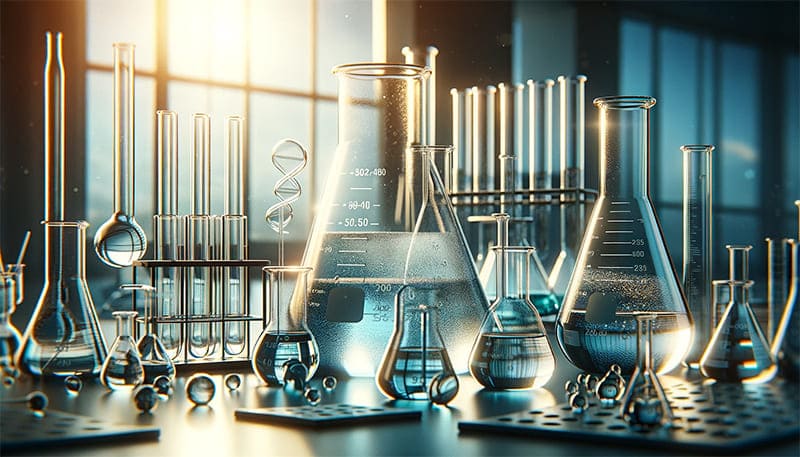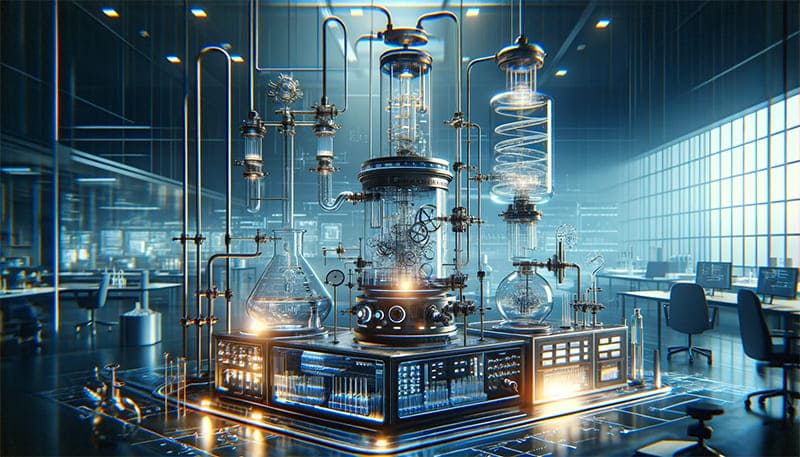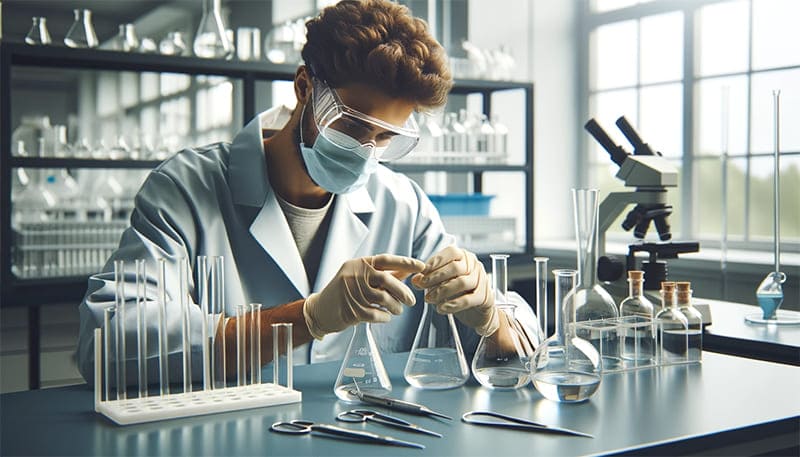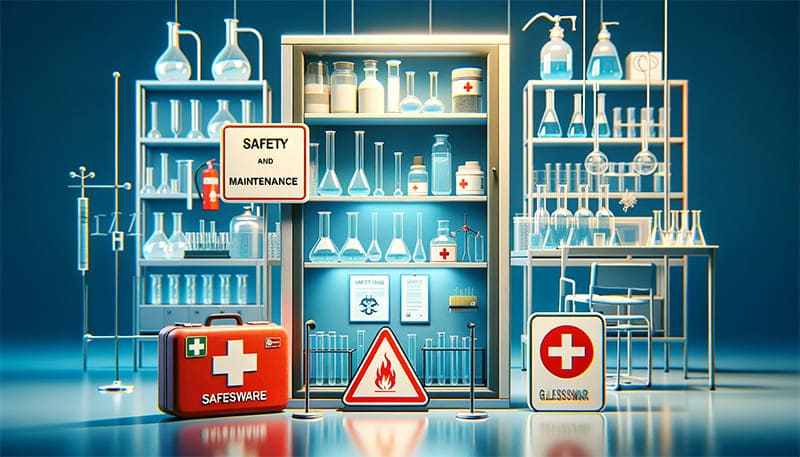Have you ever wandered through a chemistry lab, marveling at the array of shiny glassware? Each piece, from beakers to burettes, plays a crucial role in experiments. But what exactly are these tools, and why are they so important? This comprehensive guide will illuminate the world of laboratory glassware, revealing its types, uses, and care tips.
Laboratory glassware is more than just equipment; it’s the backbone of any successful chemical experiment. It offers precision, safety, and reliability, essential for accurate results.

What Are the Different Types of Laboratory Glassware?
Glassware in a chemistry lab is categorized into several types, each designed for specific purposes. Understanding these categories is key to choosing the right glassware for your experiments.
The classification of glassware in a chemistry laboratory can be divided into several main categories:
- Burner Equipment: This includes beakers, flasks, test tubes, and conical flasks. These instruments can be used for direct or indirect heating.
- Measuring Equipment: This category comprises measuring cylinders, measuring cups, volumetric flasks, burettes, and pipettes. These instruments are primarily used for accurately measuring or roughly estimating the volume of liquids.
- Container Equipment: These are used for storing or holding various chemical reagents in solid, liquid, or gaseous forms, such as reagent bottles.
- Separation Equipment: Instruments used for filtering, separating liquids, extraction, distillation, incineration, crystallization, and fractional distillation fall under this category.
- Solid Holding Equipment: These are used for fixing and holding various instruments, supplies, or devices.
- Heating Equipment: This category includes items or instruments used for heating purposes.
- Supporting Equipment: These are used for assembling or connecting instruments, such as glass tubes, glass valves, rubber tubes, and rubber stoppers.
In addition to these, a chemistry laboratory may have other types of glassware, such as condensers and evaporators. Selecting the appropriate glassware according to the specific experimental needs and purposes is crucial for ensuring the accuracy and safety of the experimental results.

Detailed Exploration of Each Type of Laboratory Glassware
To better understand the use of each type of glassware in a chemistry lab, let’s delve into the specific functions and features of these categories. This will help in selecting the right glassware for various experimental needs. Each type has a unique role, crucial for different laboratory processes.
1. Heating Instruments
Beakers
Beakers are among the most versatile pieces of glassware in a lab. They come in various sizes and are used for mixing, heating, and stirring chemicals. Beakers have a wide mouth for easy pouring and are marked with volume graduations for rough measurements.
Erlenmeyer Flasks
Erlenmeyer Flasks, also known as conical flasks, have a narrow neck and a flat bottom. They are ideal for mixing chemicals by swirling, as the narrow neck minimizes spillage. These flasks can also be used for heating and cooling solutions.
Test Tubes
Test Tubes are small glass tubes used for holding, heating, or shaking small amounts of liquid or solid chemicals. They are essential for conducting small-scale reactions or for sample storage.
Bunsen Burners
A staple in any chemistry lab, Bunsen Burners provide a controllable flame used for heating glassware and their contents. They are crucial for experiments that require precise heating.
2. Measuring Instruments
Graduated Cylinders
Graduated Cylinders are used for accurately measuring liquid volumes. They are more precise than beakers and are essential for experiments where exact volume measurements are crucial.
Pipettes
Pipettes come in various forms, including volumetric pipettes and micropipettes, for transferring precise volumes of liquids. They are crucial for titrations and other experiments requiring exact volume measurements.
3. Storage Containers
Reagent Bottles
Reagent Bottles are used for storing chemical reagents. They are usually made of glass to resist chemical reactions and are available in different sizes. Some reagent bottles are designed to protect light-sensitive chemicals from sunlight.
4. Separation Instruments
Separatory Funnels
Separatory Funnels are used in liquid-liquid extractions to separate components based on their different densities. They are typically conical or pear-shaped with a stopcock at the bottom for controlled release of liquids.
Distillation Apparatus
Distillation Apparatus is used for purifying liquids by heating them to create vapor and then cooling to condense the vapor back into a liquid. This apparatus is essential for separating mixtures based on boiling points.
5. Solid Handling Instruments
Crucibles
Crucibles are small cups made of porcelain or metal used for heating substances to very high temperatures, often for chemical analysis.
6. Heating Accessories
Hot Plates
Hot Plates are used for heating glassware and their contents without an open flame. They provide a stable and controllable heat source.
7. Supporting Accessories
Clamps and Stands
Clamps and Stands are used to hold and secure various pieces of glassware during experiments. They are crucial for setting up apparatus for complex experiments.
8. Volumetric Flasks
Like beakers and Erlenmeyer flasks, Volumetric Flasks are essential for precise measurements in a laboratory. These flasks have a unique flat bottom and a long neck with a single calibration mark, designed specifically for preparing accurate solution concentrations. They require careful handling, similar to Erlenmeyer flasks, to avoid chipping, particularly around the delicate neck and calibration mark. Cleaning them thoroughly and drying them before storage is as crucial as it is for beakers and test tubes.
9. Büchner Flasks
In conjunction with apparatus like Büchner funnels, Büchner Flasks facilitate vacuum filtration, akin to the separation role played by separatory funnels. The key is ensuring a tight seal, similar to how one would secure a distillation apparatus. Regular inspection for stress cracks, especially when used under vacuum, is as critical as checking a distillation apparatus for integrity before use.
10. Petri Dishes
A counterpart to test tubes in biological applications, Petri Dishes are indispensable in microbiological studies. Just as one would handle test tubes with care to avoid cross-contamination, Petri dishes require meticulous sterilization to maintain their utility in culturing cells and microorganisms. Their maintenance involves similar protocols to glassware like beakers, with thorough cleaning and sterilization.
11. Dropping Bottles
Dropping Bottles, while not used for direct heating like Bunsen burners or hot plates, play a pivotal role in controlled dispensation of liquids, akin to the precision offered by pipettes. Their maintenance involves ensuring the cleanliness of both the bottle and dropper, paralleling the care one would take with pipettes to avoid cross-contamination.
12. Watch Glasses
Serving a role similar to that of beakers in terms of versatility, Watch Glasses are used for a variety of purposes, including as evaporation surfaces and as covers to prevent contamination. Their maintenance and handling require the same level of care as beakers, ensuring cleanliness and avoiding rough handling to prevent breakage.
13. Mortar and Pestle
Mortar and Pestle, made of glass, are akin to crucibles in their role of altering the physical form of a substance, though through grinding rather than heating. Their maintenance involves immediate cleaning, much like crucibles, to avoid residue buildup.
14. Funnels
Funnels are to liquid transfer what pipettes are to liquid measurement – essential. They require stability during use and careful cleaning post-use, much like pipettes and graduated cylinders, to ensure accuracy and longevity.
15. Desiccators
Desiccators perform a unique function, similar to reagent bottles, in terms of storage but with a focus on maintaining a moisture-free environment. Regular replacement or regeneration of the desiccant, akin to the careful storage of chemicals in reagent bottles, is crucial for their continued effectiveness.
16. Condensers
Similar to the role Bunsen burners play in heating, Condensers are key in cooling and condensation processes, especially in distillation setups. Their maintenance is akin to that of distillation apparatus, requiring thorough cleaning and careful handling to ensure integrity.
17. Gas Collection Bottles
Gas Collection Bottles are to gas experiments what test tubes are to liquid or solid samples. They necessitate careful handling and regular cleaning, much like test tubes, to ensure accuracy and safety in gas-related experiments.
18. Stirring Rods
Stirring Rods complement beakers and flasks, much like Bunsen burners complement heating instruments, by facilitating manual mixing. Their maintenance is straightforward, involving regular cleaning and inspection for damage.
In integrating these additional glassware types, we see how each piece, from the common beaker to the specialized Büchner flask, plays a vital role in the laboratory. Each requires specific care and handling, much like the instruments we initially discussed. Together, they form a comprehensive toolkit essential for the diverse and dynamic world of scientific experimentation. Understanding and properly maintaining this glassware ensures not only the success of experimental procedures but also the safety and efficiency of the laboratory environment.

Advanced Glassware and Their Applications
1. Specialized Glassware
Condensers
Condensers are used in distillation processes to cool hot vapors, turning them back into liquid. Types like the Liebig condenser are common in labs for reflux and distillation operations.
Burettes
Burettes are essential in titrations for dispensing known volumes of a liquid reagent, typically an acid or a base. They allow for precise control of liquid flow, crucial for determining the concentration of unknown solutions.
2. Complex Glassware Systems
Soxhlet Extractors
Soxhlet Extractors are used for continuous extraction of a compound from a solid material into a solvent. They are used in organic chemistry labs for extracting natural compounds, like lipids from solid matrices.
Rotary Evaporators
Rotary Evaporators, or rotavaps, are used for the gentle and efficient removal of solvents from samples by evaporation. They are particularly useful in chemistry and biology labs for sample preparation.
3. Custom Glassware
Certain experiments require Custom Glassware, designed specifically for unique applications. These pieces are crafted to cater to specialized requirements that standard glassware cannot fulfill.
Choosing the Right Glassware
Selecting the appropriate glassware is crucial for any experiment. Consider factors like:
- Chemical Compatibility: Ensure the glassware is resistant to the chemicals being used.
- Temperature and Pressure Requirements: Some experiments require glassware that can withstand extreme conditions.
- Volume and Size Needs: Match the size of the glassware with the scale of the experiment.

Detailed Usage Precautions and Maintenance Tips for Key Laboratory Glassware
Continuing from our exploration of the diverse world of laboratory glassware, let’s now delve deeper into the specific precautions and maintenance tips for each type of glassware. This information is vital for ensuring the longevity of your glassware and the safety and accuracy of your experiments.
1. Beakers
- Usage Precautions: Beakers should be handled carefully to avoid sudden temperature changes, which can cause cracking. They are not suitable for precise measurements due to their approximate volume markings.
- Maintenance Tips: Regular cleaning with a brush and a suitable detergent is recommended. Rinse thoroughly and dry before storage.
2. Erlenmeyer Flasks
- Usage Precautions: Gradually increase temperature when heating. Avoid tightly sealing them while the contents are hot to prevent pressure build-up and potential breakage.
- Maintenance Tips: Immediate rinsing after use is advisable. A brush can be used for effective cleaning.
3. Test Tubes
- Usage Precautions: Always use test tube holders for hot tubes. Metal spatulas should be avoided to prevent scratching the glass.
- Maintenance Tips: A small brush is ideal for cleaning. Soaking in a cleaning solution can help remove stubborn residues.
4. Burettes
- Usage Precautions: Ensure smooth operation of the stopcock for accurate liquid flow control. Handle them vertically to prevent breakage.
- Maintenance Tips: Store with the stopcock open. Regular cleaning with a burette brush is essential.
5. Pipettes
- Usage Precautions: Use pipette fillers instead of mouth pipetting. Ensure the tip is always submerged to avoid air intake.
- Maintenance Tips: Immediate rinsing with distilled water is recommended. Regular calibration checks are essential for accuracy.
6. Graduated Cylinders
- Usage Precautions: For accurate readings, place on a level surface. Avoid using them for reactions that produce gases.
- Maintenance Tips: Clean with a long brush and store them upright in a secure place.
7. Volumetric Flasks
- Usage Precautions: Fill only to the mark for precise measurements. Not meant for mixing or heating substances.
- Maintenance Tips: Ensure thorough rinsing and drying. Avoid scrubbing the marked line.
8. Condensers
- Usage Precautions: Proper water flow for cooling is crucial during distillation. Handle with care to avoid damaging the inner tube.
- Maintenance Tips: Immediate post-use water flushing is advisable. Use a flexible brush for interior cleaning if needed.
9. Reagent Bottles
- Usage Precautions: Clearly label each bottle. Protect light-sensitive chemicals from direct sunlight.
- Maintenance Tips: Clean thoroughly between uses and ensure a tight seal to prevent contamination.
10. Soxhlet Extractors
- Usage Precautions: Correct assembly is crucial. Monitor the heating source to avoid overheating.
- Maintenance Tips: Clean each component individually and check the siphon tube for blockages.
11. Rotary Evaporators
- Usage Precautions: Ensure balanced flask placement to avoid wobbling. Adhere to recommended speed and temperature settings.
- Maintenance Tips: Maintain the vacuum seal regularly and clean all glass parts after use.
12. Petri Dishes
- Uses: Primarily used in biology for culturing cells, bacteria, and other microorganisms. They come in different sizes and can be used for observing microbial growth and behavior.
- Precautions: Sterilization before use is crucial to prevent contamination. Handle with care to maintain sterility.
- Maintenance: Clean and sterilize after each use. Store in a dry and dust-free environment.
13. Watch Glasses
- Uses: These are concave dishes used for holding small quantities of substances during experiments. They can also be used to cover beakers, preventing contamination or evaporation.
- Precautions: Handle gently to avoid breakage. Not suitable for mixing reactive chemicals.
- Maintenance: Clean with mild detergent and rinse thoroughly. Dry and store in a secure place.
14. Dropping Bottles
- Uses: Used for dispensing small amounts of liquids drop by drop. Common in titrations and when adding reagents in controlled quantities.
- Precautions: Ensure the dropper is clean to avoid contamination. Do not squeeze too hard to prevent excessive dispensing.
- Maintenance: Clean the bottle and dropper separately. Dry thoroughly before reuse.
15. Mortar and Pestle
- Uses: Although not always made of glass, glass versions are used for grinding or crushing chemicals into powder form.
- Precautions: Ensure the mortar is stable during use. Avoid using with very hard materials that can cause chipping.
- Maintenance: Wash and dry thoroughly after each use. Inspect for any signs of wear or damage.
16. Desiccators
- Uses: Used to store chemicals in a dry atmosphere. They contain desiccants like silica gel to absorb moisture.
- Precautions: Handle with care to maintain an airtight seal. Monitor the desiccant to ensure it remains active.
- Maintenance: Regularly replace or regenerate the desiccant. Clean the desiccator carefully to maintain its integrity.
17. Funnels
- Uses: Used for transferring liquids into containers with small openings. Some funnels, like the Buchner funnel, are used in conjunction with a filter for separating solids from liquids.
- Precautions: Ensure the funnel is stable and secure during use. Use an appropriate filter type for Buchner funnels.
- Maintenance: Clean after each use, ensuring no residue is left. Store in a way that prevents chipping or cracking.
18. Gas Collecting Bottles
- Uses: Used for collecting and measuring gases produced in reactions.
- Precautions: Ensure airtight connections to prevent gas leakage. Handle with care as they often contain pressurized gases.
- Maintenance: Regular cleaning and inspection for cracks are essential. Store in a safe, stable position.
19. Stirring Rods
- Uses: Glass rods used for manually stirring mixtures or solutions in lab containers.
- Precautions: Use gently to avoid breaking the glass container. Clean immediately after use to avoid residue hardening.
- Maintenance: Wash with detergent and rinse well. Inspect for any signs of wear or damage.
General Advice
When working with any type of laboratory glassware, it’s crucial to always follow standard laboratory safety protocols. Proper handling, cleaning, and storage of glassware are not only essential for the longevity of the equipment but also for the safety of the laboratory personnel and the integrity of the experiments being conducted.
By familiarizing yourself with these additional types of glassware and their specific uses and care, you can further enhance your laboratory skills and contribute to successful and safe scientific research.

Safety and Maintenance
Proper handling and maintenance of laboratory glassware are as important as understanding their uses. Always follow these guidelines:
- Inspect Glassware Before Use: Check for any cracks or chips. Damaged glassware can lead to accidents.
- Clean After Use: Residues can affect future experiments. Use appropriate cleaning agents and methods.
- Handle with Care: Glassware can break easily and cause injury. Use protective gear like gloves and goggles.
- Store Properly: Organize glassware in designated areas to prevent damage and contamination.
Trends and Innovations in Laboratory Glassware
Advancements in glassware technology have led to improved safety and efficiency in labs. For example:
- Coated Glassware for added safety, reducing the risk of injury from shattered glass.
- Self-cleaning Glassware using hydrophobic coatings, making maintenance easier.
- Smart Glassware with embedded sensors for monitoring temperature, pH, or pressure during experiments.
Conclusion
The realm of laboratory glassware is vast and continually evolving. From basic beakers to complex rotary evaporators, each piece plays a vital role in the scientific discovery process. By understanding and utilizing these tools effectively, we can push the boundaries of research and innovation.
As you dive deeper into the world of laboratory glassware, remember to always prioritize safety and accuracy. For more comprehensive insights and specific guidelines, consult detailed scientific resources and laboratory safety manuals. The journey through the intricate world of laboratory glassware is both fascinating and fundamental to scientific progress.
We encourage you to delve deeper, to experiment, to question, and to continually seek knowledge. Whether you’re in a classroom setting, a professional lab, or even exploring science from a home lab, let your curiosity lead the way. Embrace the learning process, as each experiment, each success, and even every failure, is a step forward in the vast expanse of scientific exploration.
Your next discovery could be just around the corner, waiting for you in the next test tube or Petri dish. Let’s continue to push the boundaries of research and innovation, one piece of glassware at a time.










